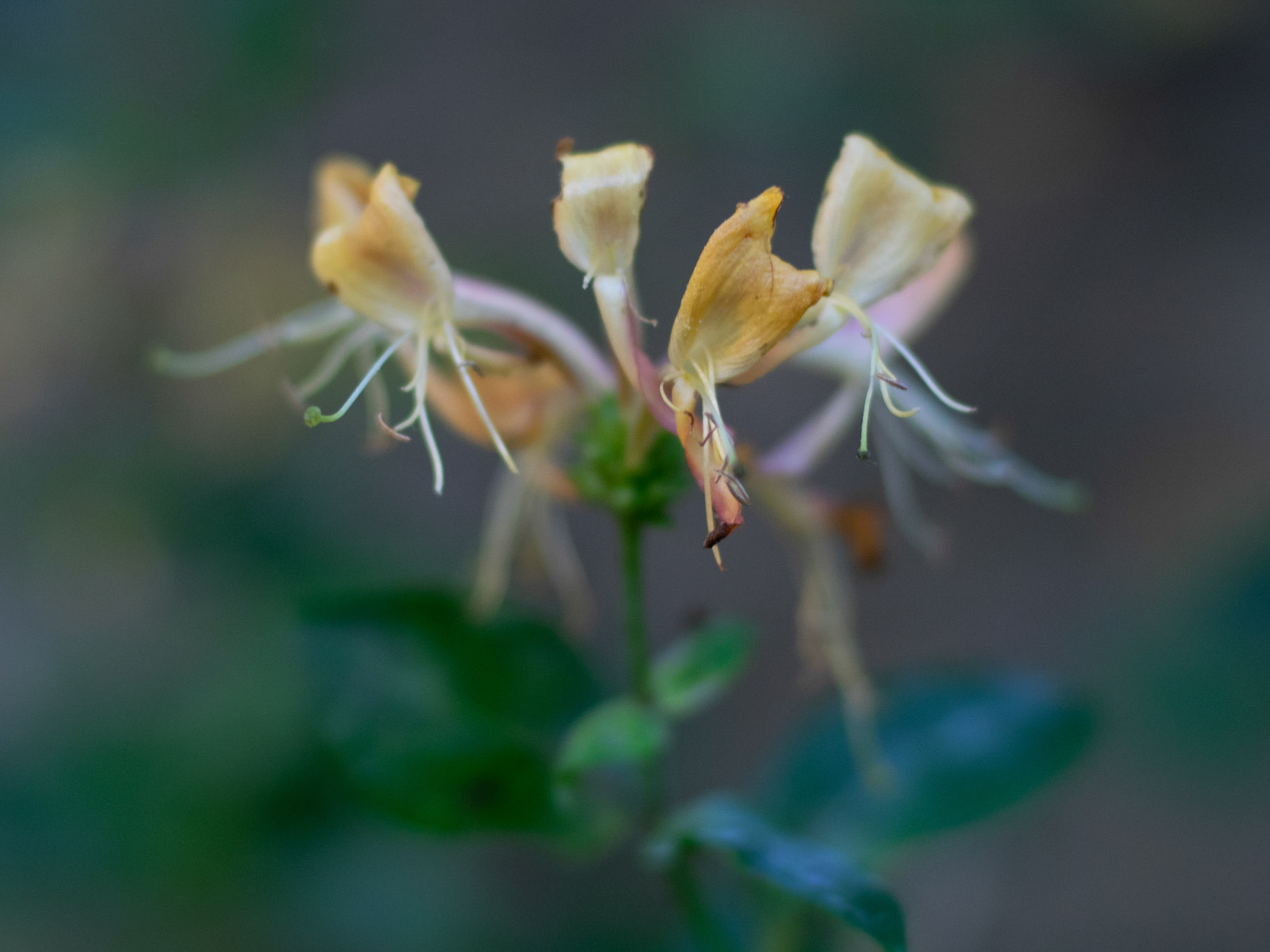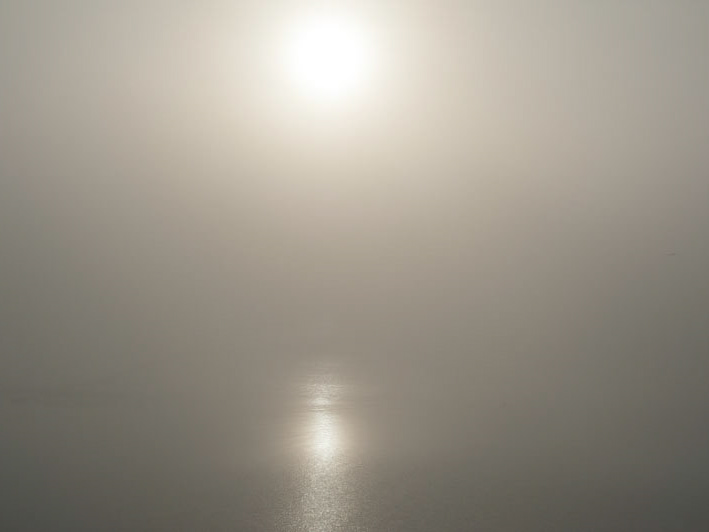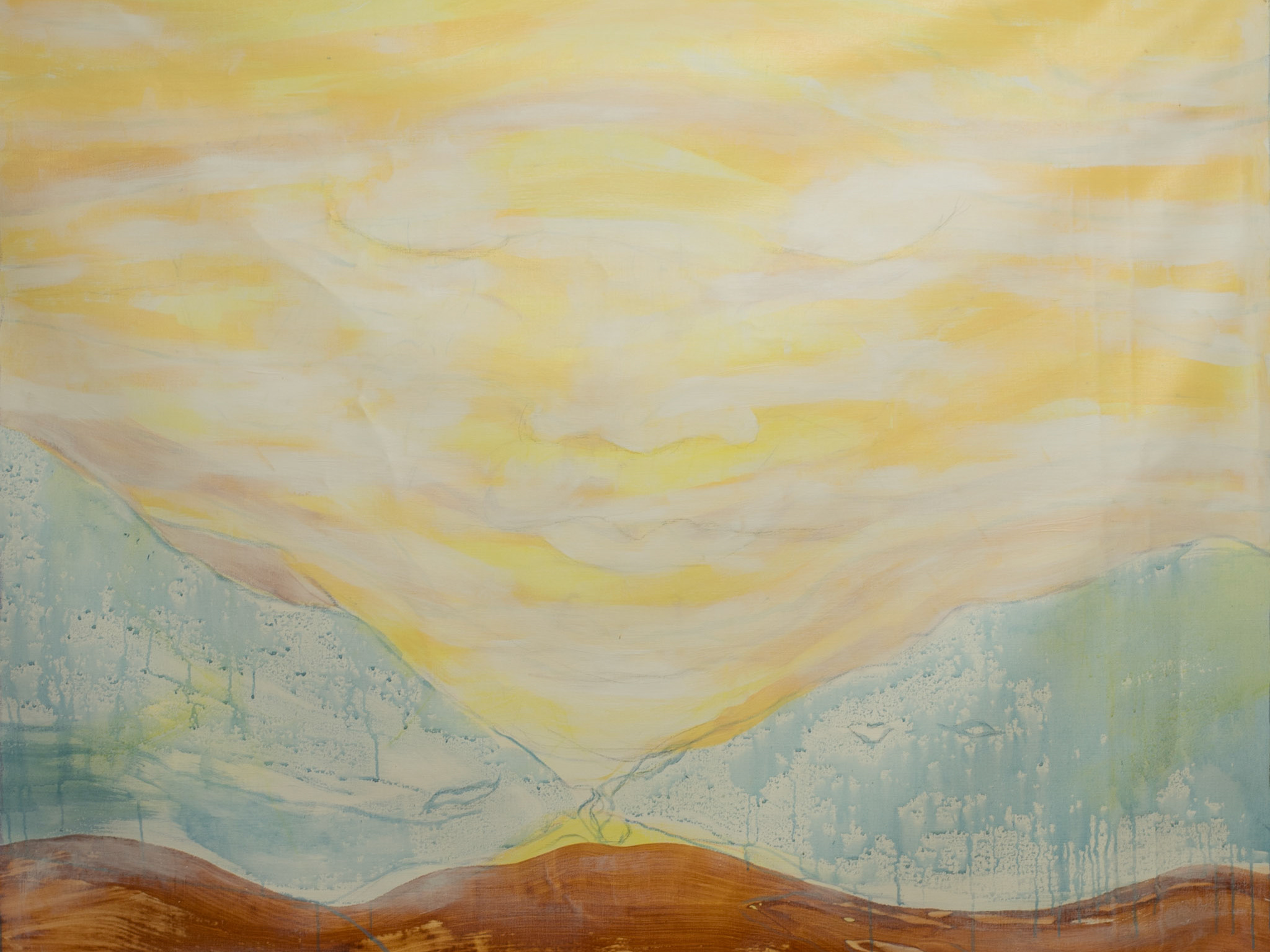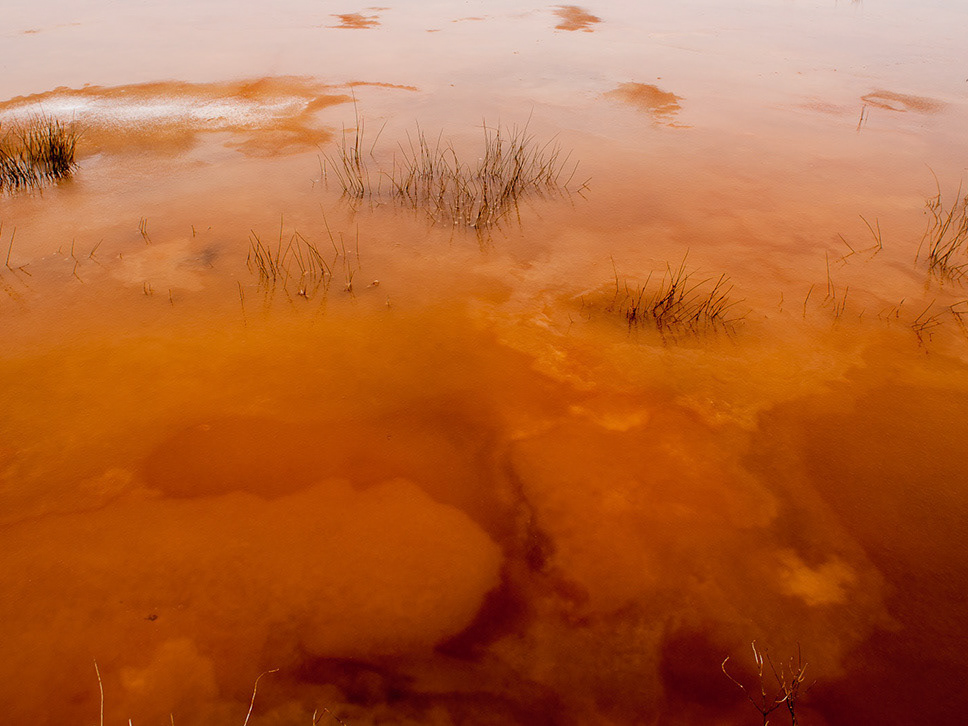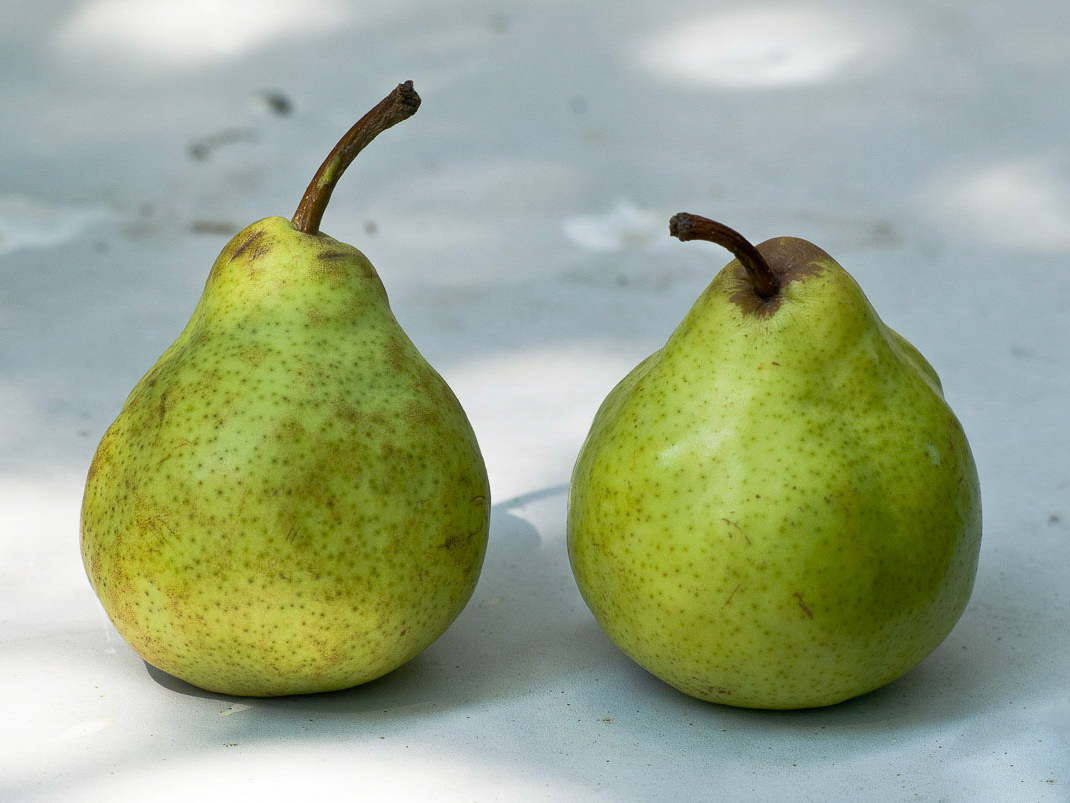
Op de bodem van de bron maakt Leptorhtix Ochrea een geletine achtige laag. Mid-vooraan maakt Leptothrix Discophora haar doorzichtige, "polymeer-achtige" film op het water. Nu is de film bijna onzichtbaar, maar vanuit een andere kijkhoek met de zon 'breekt' het licht op de film en het water, en mengen een beetje van elkaar verschoven lichtgolven zich tot alle kleuren van de regenboog: interferentie-kleuren.

leptothrix discophora in het blauwe uur, op de oppervlakte van een sloot in een kwelgebied. Deze opname werd gemaakt op 12 februari, in een gehekkelde sloot. De relatief egale interferentie-kleur kan zo worden waargenomen tijdens "het blauwe uur", als de hemel een mooie koepel van diffuus blauw licht maakt.

interferentie.

als de film veroudert wordt ze bruin. er is stroming middenin, daar zit het oudere kwelwater, aan de kanten stroomt versere kwel in de sloot.

oliefilm geeft ook van die prachtige interferentiekleuren, en lijkt bij oppervlakkinge beschouwing op l.discophora. Een oliefilm breekt niet, vloeit weer samen. de l.discophorus-film breekt en kan rimpelen. De foto is "uit de hand" genomen, met de sensor op 3200 iso ingesteld om in ieder geval met een redelijk hoge (1/100 sec) sluitersnelheid te kunnen werken. In de ruis gaat informatie verloren.

leeftijdsverschillen in de film laten stromingspatronen zien, als een soort leeftijdsringen. Hoe blauwer en lichter hoe jonger, hoe geler/bruiner hoe ouder.

ijzer is het eerste element, dat in de tweede generatie sterren wordt gemaakt. De zwaartekracht van waterstof en helium is groot genoeg om de lichtere elementen te smeden. Lithium, natrium, kalium, aluminium. Als sterren van de eerste generatie door hun eigen zwaartekracht imploderen en "nova" gaan, verzamelt de "as" zich na miljoenen jaren zwaartekracht in nieuwe sterren, met genoeg lichte metalen om zwaardere elementen te smeden.












1. episetum wakes up, a bringer for oxygen spreads her wings
There are only scientific names for omnipresent creatures like the rock-eating bacteria 'Leptothrix Discophora' and 'Leptothrix Ochracea'. They are very old species, "first lifers" in geological 'deep time', they are some 2.5 billion years around.
L. Discophora bacteria get their 'breaths' by reducing iron. L. Ochracea 'breaths' by oxidizing reduced iron.
Leptothrix Discophora makes a film on iron-rich groundwater. Perhaps the film looks like a pollution, but it ain't, it's just mother nature's cauldron at work, fused by sunlight.

8. midsummer faultlines
The film from iron-breathing bateria that is coverd with pollen, has become more diffuse and the reflectiion is fitered to a kind of greenish yellow. The wind has moved the center-part of the film faster then the edges from the ditch and makes mini 'thrustfaults'. The goldish-ochre shading is from its 'counterpart', "ochracea discophora", that made rust in film while in the darknes of the tree-shadow and it's more light loving counterpart was deprived of photons to do the reduction. And perhaps, with a touch of sulphor you get shades of pyrite.




Deep time alive. leptothrix discophora and leptothrix ochracea are very old species, first lifers from mother earth. Those bacteria belong to the class 'rockeaters', digest iron and do their magic on a wave of fotons and electrons. Leptothrix discophora makes a film on water with iron in it, here mineral rich groundwater. That film looks like an oil pollution, but it isn't pollution, just nature's couldron at work fused by sunlight. One can see the differece by touching the film: l.diicophora's film breaks when touched, oil flows together after touch. Here , midsummer, the film is couvered with pollen and is kind of greenish. The wind has moved the mid of the film faster then the edges in the ditch and makes mini 'thrustfaults'. The goldish-ochre shading is from its 'counterpart', "ochracea discophora", while in the shadow of the tree. it makes rust and feeds on the iron from it's more light loving counterpart. And with a touch of sulphor you get shades of pyrite, "fools gold".



into the cauldron: a floccule of L. Ochracea came afloat, thanks to it's exhaust-gasses. between L. Discophora, Potamogeton natans and a moth, Pieris napi.

into the cauldron 2


6. into the cauldron.
It is High-summer. The ditches and ponds in the wetlands are teeming with life. As if everything wants to integegrate you, make you a an esdible part in the cauldrons of the biosphere. in the swamps the you have to cover your bare skin and wear a mosquito-hat to survive the insects. This image was made during the 'blue hour'. Then the sky makes a blue canopy without uni-directional light, so the blue is reflected in the film is without the extreme contrasts that sunbeams produce.
Because sunlight has a direction, interferece-colours can only be seen from an angle. It is impossible to photograph them parallel the watersurface. An angle of 90o to the light-ray is needed to observe the phenomena.
The recepie for this concoction is: neutral to base groundwater, that has gone through iron rich layers in the ground, some organic material, warmth and light. The mars-red floccules are colonies of probably L. Ochracea, that came afloat thanks to the gasses that are produced as 'waste' in the floccules.

'the cauldron'.

full moon interference

Deep time in the wetlands behind my home: leptothrix discophora and leptothric ochraceae, both bacteria that digest, or more appropriate, breath, iron. The blue film on the water ain't no oil, it is a colony of leptothrix discophora floating on the water while reducing "rust" in the water. The ochre-reddish blobs in the water are colonies from it's counterpart, "leptothrix ochraceae". They oxidize iron. Together they not only make a natural battery, but in the history of earth they are the "first lifers" on our planet, they have been around for more then 2000 000 000 years.

4. deep time in the Lowlands.
In late autumn the ditches in the wetland have just been cleaned, the surfacing relative warm (± 6 centigrades) groundwater is to cold for algae and new growths. So L. Discophora and L. Ochracea have a good time and give shape to a prehistoric landscape. Their works result in deposits of iron-ore. In former times this 'bog-iron' was harvested and blasted to steel in furnaces.
In late autumn the ditches in the wetland have just been cleaned, the surfacing groundwater is to cold for algae and new growths. So L. Discophora and L. Ochracea have a good time and give shape to a prehistoric landscape. Their works result in deposits of iron-ore. In former times this 'bog-iron' was harvested and blasted to steel in furnaces.

Deep time in the wetlands behind my home: leptothrix discophora and leptothric ochraceae, both bacteria that digest, or more appropriate, breath, iron. The blue film on the water ain't no oil, it is a colony of leptothrix discophora floating on the water while reducing "rust" in the water. The ochre-reddish blobs in the water are colonies from it's counterpart, "leptothrix ochraceae". They oxidize iron. Together they not only make a natural battery, but in the history of earth they are the "first lifers" on our planet, they have been around for more then 2000 000 000 years.

Deep time in the wetlands behind my home: leptothrix discophora and leptothric ochraceae, both bacteria that digest, or more appropriate, breath, iron. The blue film on the water ain't no oil, it is a colony of leptothrix discophora floating on the water while reducing "rust" in the water. The ochre-reddish blobs in the water are colonies from it's counterpart, "leptothrix ochraceae". They oxidize iron. Together they not only make a natural battery, but in the history of earth they are the "first lifers" on our planet, they have been around for more then 2000 000 000 years.

Deep time in the wetlands behind my home: leptothrix discophora and leptothric ochraceae, both bacteria that digest, or more appropriate, breath iron. The blue film on the water ain't no oil, it is a colony of leptothrix discophora floating on the water while reducing "rust" in the water into pure iron (Fe with no O). The ochre-reddish blobs in the water are colonies from it's counterpart, "leptothrix ochraceae". They oxidize iron. Together they not only make a natural battery, but in the history of earth they are the "first lifers" from our planet, they have been around for more then 2000 000 000 years.

ochra

ochra

ochra

ochra

ochra

OLYMPUS DIGITAL CAMERA

OLYMPUS DIGITAL CAMERA

OLYMPUS DIGITAL CAMERA

OLYMPUS DIGITAL CAMERA

OLYMPUS DIGITAL CAMERA

OLYMPUS DIGITAL CAMERA

OLYMPUS DIGITAL CAMERA

OLYMPUS DIGITAL CAMERA

OLYMPUS DIGITAL CAMERA

OLYMPUS DIGITAL CAMERA

OLYMPUS DIGITAL CAMERA

OLYMPUS DIGITAL CAMERA

OLYMPUS DIGITAL CAMERA

OLYMPUS DIGITAL CAMERA

OLYMPUS DIGITAL CAMERA

OLYMPUS DIGITAL CAMERA

OLYMPUS DIGITAL CAMERA

OLYMPUS DIGITAL CAMERA

OLYMPUS DIGITAL CAMERA

OLYMPUS DIGITAL CAMERA

OLYMPUS DIGITAL CAMERA

OLYMPUS DIGITAL CAMERA

OLYMPUS DIGITAL CAMERA

OLYMPUS DIGITAL CAMERA

OLYMPUS DIGITAL CAMERA

OLYMPUS DIGITAL CAMERA

OLYMPUS DIGITAL CAMERA

OLYMPUS DIGITAL CAMERA

OLYMPUS DIGITAL CAMERA

OLYMPUS DIGITAL CAMERA

OLYMPUS DIGITAL CAMERA

OLYMPUS DIGITAL CAMERA

OLYMPUS DIGITAL CAMERA

OLYMPUS DIGITAL CAMERA

OLYMPUS DIGITAL CAMERA






















































































